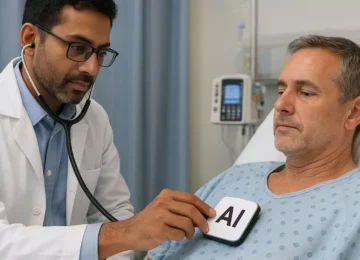Over 10,000 New Medical Seats Approved in Government Colleges
In making a major boost to medical education in India, the Union Ministry of Health and Family Welfare has approved more than 10,000 new medical seats in government medical colleges across the country. This expansion is part of the government’s ongoing efforts to increase the reach of healthcare, strengthen the ratio of doctor-to-yogi and increase the quality of medical education in India.
The decision is especially stated as an important step towards addressing the rapid decrease of doctors in rural and semi-urban areas, where health facilities often struggle to meet the demand.
Main details of approval
The ministry announced that 10,103 new MBBS seats have been approved for the 2026-27 academic session. These seats will be added to more than 50 government medical colleges in various states.
- States with maximum seats: Uttar Pradesh, Maharashtra, Tamil Nadu, Karnataka and West Bengal are among the top states that are getting the highest part of the new seats.
- Objective: The objective of additional seats is to increase the annual MBBS intake from 1.8 lakh to about 1.9 lakh students, which is aligning the government’s approach to the government’s approach to provide quality healthcare across India.
- Infrastructure Support: Each newly approved seat is accompanied by the development of infrastructure, including classes, laboratories, hostels and faculty recruitment.
A senior ministry official said, “This expansion reflects our commitment to strengthen the healthcare system in especially underserved areas, by training more competent doctors.
Addressing Doctor Shortages
India currently has a doctor-to-population ratio of about 1:1,200, below the World Health Organization’s recommendation of 1:1,000. Rural areas are unevenly affected, with more than 70% of doctors focused in urban areas, leaving villages and small cities.
- By adding more seats in government colleges, the objective of the government is:
- Increase in availability of medical workforce, especially in rural and semi-urban areas.
- Encourage students of diverse backgrounds to pursue higher education through more accessible government institutions.
Ensure regional balance by opening seats in states with historically low medical colleges.
Healthcare Policy Specialist Dr. Anjali Mehta said, “Extending MBBS seats in government colleges is a positive step. It will help to meet the needs of growing health services, reduce dependence on private colleges and improve the availability of doctors across the country.”
Impact on Medical Education
Government medical colleges have traditionally been preferred for their affordability and quality of training, compared to private institutions that often charge high fees. The new seats will allow more meritorious students to access quality medical education at a lower cost.
- Curriculum & Faculty: The Medical Council of India (MCI) guidelines ensure that new seats are accompanied by sufficient faculty recruitment, clinical material, and practical training facilities.
- State Distribution: States like Uttar Pradesh and Maharashtra will see a rise of over 1,500 seats each, while smaller states like Chhattisgarh and Odisha will also benefit, improving regional healthcare capacity.
- Hospital Integration: Each new seat is linked to teaching hospitals where students will undergo clinical training, further strengthening local healthcare infrastructure.
The Health Ministry has also emphasized digital classrooms, simulation labs, and telemedicine integration to enhance learning outcomes.
Implications for Healthcare
Extending medical seats is expected to have a long-term positive impact on India’s healthcare system:
- Availability of better doctors: especially in districts with an acute decrease.
- Increased healthcare access: More trained doctors can provide services in primary and secondary health centers.
- Promotion of medical research: Big student colleagues will encourage innovation and research in medical and public health.
- Dependence on private colleges will be less: Cheap government seats will make medical education accessible for all socio-economic backgrounds.
Senior faculty of AIIMS Delhi, Dr. Rajesh Kumar, said, “The expansion of government medical seats not only helps in the production of more doctors, but also strengthens tertiary healthcare institutions by ensuring more trainees on hand in teaching hospitals.”
Government Strategy & Vision
The new seats are part of the government’s broader National Health Mission and “Ayushman Bharat” initiatives aimed at universal health coverage. Key points include:
- Focus on strengthening existing medical colleges before opening new ones.
- Ensuring quality of education by maintaining student-faculty ratios, improving hospital facilities, and upgrading labs.
- Prioritizing seats in states with doctor shortages to reduce regional disparities.
Union Health Minister stated, “Our vision is to create a self-sufficient medical education system that caters to the growing needs of our population. These new seats will ensure that every child aspiring to become a doctor gets an opportunity, and patients across India receive timely medical care.”
Expert Opinions
Healthcare analysts and medical educators have largely welcomed the decision. Key observations include:
- Positive Step: Expanding seats in government colleges ensures more students can pursue medicine without a financial burden.
- Infrastructure Challenges: Some experts caution that merely increasing seats is not enough; colleges must maintain infrastructure, faculty, and patient load for practical exposure.
- Long-Term Benefits: More doctors graduating from government institutions will gradually improve the doctor-patient ratio, especially in rural areas.
Dr. Shalini Verma, a public health consultant, remarked, “It is crucial to monitor implementation. Proper infrastructure and clinical exposure are essential to ensure that these new graduates are competent and ready to serve communities.”
Statistics & Future Outlook
- Current Seats: Before this expansion, India had roughly 81,000 MBBS seats across government and private colleges combined.
- Post-Expansion: With over 10,000 additional seats, the total in government colleges will rise to around 55,000–56,000 seats, reducing pressure on private institutions.
- Projected Impact: By 2030, the doctor-to-population ratio is expected to improve, particularly in underserved regions, if current expansion and policy measures continue.
Conclusion
The approval of over 10,000 new medical seats in government colleges marks a historic step for India’s medical education sector. By addressing doctor shortages, increasing affordable access to quality medical education, and strengthening healthcare infrastructure, this move is expected to have a long-lasting impact on public health across the country.
While the immediate challenge remains to implement these seats with proper infrastructure and faculty support, the initiative represents a major step toward creating a robust and equitable healthcare system for India.













